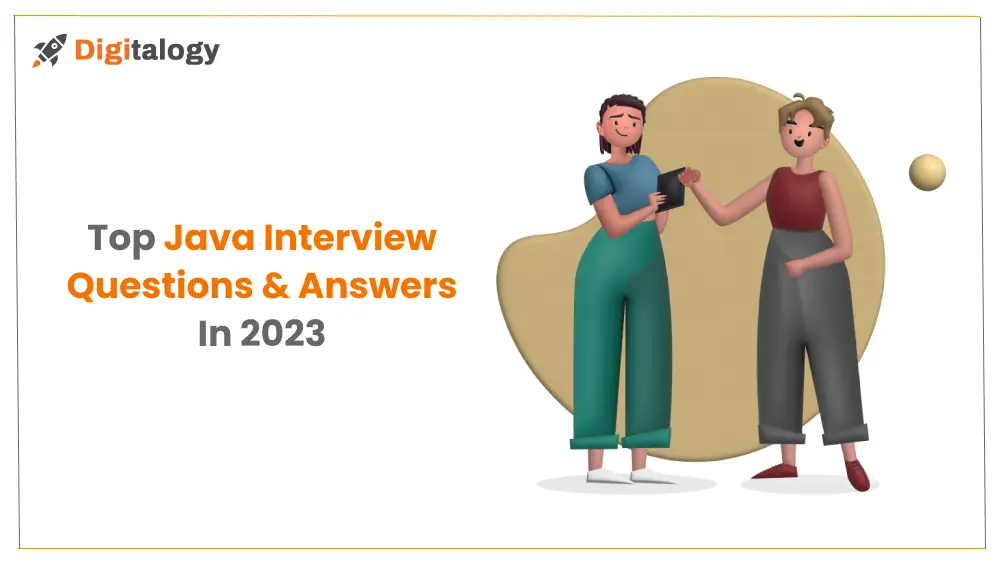The technical world has seen major changes. Every day new technologies, software, and programs are introduced, which constantly help in the evolution of technology. However, a few software remain consistent in this phase of evolution, Java being one of them. Java was launched decades ago and has remained a great asset in the tech world since then. It has only improved over the years and has never lost its charm.
Java is a popular programming language that has always attracted developers. After learning Java, developers look for jobs in their respective fields but might face the challenge of understanding what questions can be asked in the interviews. We’ve created this blog to address this issue. Here you will find what Java is and what questions can be asked in the interview process.
What is Java?
Java is among the most popular and dynamic programming languages, It was initiated by James Gosling in June 1995 and appeared to the public in 1995. The language being object-oriented is very useful to handle high-level applications and software. The language is so old, that it still has the same demand and more because of its algorithms and libraries. It gives great competition to other languages and newbies which try to compete with Java.
What are the Uses of Java:
- Java is a scalable language helpful in developing web applications, software, mobile applications, etc.
- Java supports artificial intelligence and IoT (Internet of Things)
- Useful for developing marketing tools and chatbots
Java Interview Questions & Answers for Beginners

Q1. Is Java an independent platform language?
Ans. Yes, Java was created in such a manner that it does not require any kind of secondary database or support for its operations. There is no software or hardware needed for it. It transforms the code into independent byte code so that it can be executed on various systems after it has been compiled.
Q2. What are heap memory and stack memory?
Ans. Stack memory refers to the memory space provided to each unique program. Then it was changed. On the other side, heap memory is the portion that has not been given to Java but is nevertheless available to it if necessary, frequently while the program is being executed.
Q3. What makes Java different from C++?
Ans.
| C++ is only a compiled language. | Java is simultaneously a compiled and interpreted programming language. |
| C++ programs only run on the computer in which they are compiled. | Java programs are platform-independent. |
| References are a feature of the C++ programming language. | Java prevents it. Pointers are achieved directly by Java. |
Q4. What is the meaning of Instance Variable and Local variable?
Ans. A variable that is available by all functions in the class is called an instance variable. Outside of the procedures and within the class, they are defined. These variables continue to be linked to the item at all costs and serve to define its attributes.
The attributes will be duplicated for use by each object in the class. Only that version will be affected if any changes are made to these properties, with no effect on any other versions of the class.
Local variables are those that are found inside a block, function, or object and are only accessible within those specific areas. When utilizing them, the variable will only be utilized in blocks. The other ways in the class are unaware of any local variables that are defined inside of a method.
Q5. What do you understand about Data Encapsulation?
Ans. Data encapsulation is an Object-Oriented Programming technique that combines all data properties and actions into a single entity and conceals them from view.
It enables Java programmers to adhere to flexibility by guaranteeing that every entity is independent of others by possessing its methods, characteristics, and functions.
It is used as a data-hiding method since it protects an object’s confidential details. For example:-
public class Student {
// Private fields (variables) to encapsulate data
private String name;
private int age;
// Public constructor to initialize the object
public Student(String name, int age) {
this.name = name;
this.age = age;
}
// Public getter method to access the 'name' field
public String getName() {
return name;
}
// Public setter method to modify the 'name' field
public void setName(String name) {
this.name = name;
}
// Public getter method to access the 'age' field
public int getAge() {
return age;
}
// Public setter method to modify the 'age' field
public void setAge(int age) {
if (age >= 0) {
this.age = age;
} else {
System.out.println("Age cannot be negative.");
}
}
// Public method to display student information
public void displayInfo() {
System.out.println("Name: " + name);
System.out.println("Age: " + age);
}
public static void main(String[] args) {
// Create a Student object
Student student = new Student("Alice", 20);
// Access and modify the object's fields using methods
student.displayInfo();
student.setName("Bob");
student.setAge(22);
student.displayInfo();
}
}Output:-
Name: AliceAge: 20
Name: Bob
Age: 22
More topics for you to read: Angular Interview Questions & Answers | iOS Interview Questions & Answers | Node.js Interview Questions & Answers | Android Interview Questions & Answers
Java Interview Questions and Answers for Intermediates
Q6. What is a singleton class in Java, and how may one be used?
Ans. Classes known as singleton classes have items that are produced just once. Moreover, the class members may only be accessible by using that object.
Here is one example for better understanding:
class WaterJug{
private int waterQuantity = 500;
private WaterJug(){}
private WaterJug object = null;
// Method to provide the service of Giving Water.
public int getWater(int quantity){
waterQuantity -= quantity;
return quantity;
}
// Method to return the object to the user.
public static Waterjug getInstance(){
// Will Create a new object if the object is not already created and return the object.
if(object == null){
object = new WaterJug();
}
return object;
}
}The object of the class can not be created as the constructor is private. However, with the help of getInstance() we can easily get the object. The getInstance function may be used without generating the object because it is static. And the item is returned. With the help of that object, getWater() can be called to get water.
Waterjug glass1 = WaterJug.getInstance();
glass1.getWater(1);
This getInstance () can be utilized to get a single object. It is a thread-safe singleton class as it is static. A thread-safe singleton class can be created in a variety of ways. Thread-safe classes can, therefore also be:
- Singletons can be made thread-safe by using double-check encryption when they are created.
- Static singletons, initialized after class loading, can be used like in the example above.
- Yet, using Java enums is the simplest method to make a thread-safe singleton.
Q7. What is the difference between a String, StringBuffer, and StringBuilder?
Ans.
| The String pool is where the string’s memory is kept. Heap memory is where StringBuilder and StringBuffer are stored. | Unlike the StringBuilder and StringBuffer, which are both changeable, a String is permanent. | Working with a String is quite time-consuming. Nonetheless, StringBuilder completes tasks the quickest. In contrast to a String, a StringBuffer advances very slowly than a StringBuilder. (For example, introducing a unit takes the least time in StringBuilder and more time in String because the fresh String with the additional unit needs new memory). |
Q8. In Java, what is a comparator?
Ans. Think about the scenario in which we have a list of workers with attributes. Now, let’s arrange this list of staff according to their names. The Collections.sort() function cannot sort it. Hence it cannot be used. Based on the values we have to sort, we are required to supply a parameter to the sort() method. A comparator is then employed in such a situation.
In Java, the compare function is contained in the Comparator interface. We may provide the foundation on which we should compare the numbers by overloading the compare function.
Q9. What do you know about JDK, JRV, and JVM?
Ans. JDK: In the process of creating Java programs, we need a few JDK resources (Java Development Kit). The Java Runtime Environment and a compiler are both parts of the JDK toolkit.
JRE: To execute the Java software, we need a configuration. JVM and a Java class library are both included in the Java Runtime Environment (JRE). What is the purpose of Java Classes, and what does it consist of? It already includes several predefined methods, which makes it simpler for Java programs to build and use that capability. For example, we may send a text to the interface by using the Java print-stream function of the system class.
JVM: The Java Virtual Machine, Java programs are executed by a JRE component called JVM. Despite being a program that converts bytecode to hardware-executable code, it is essentially a JRE element.
Q10. Differentiate between HashMap and HashTable?
Ans.
| HashMap | HashTable |
| It is better for applications that are non-threaded as it is not synchronized. | It is suitable for applications that are threaded as it is synchronized. |
| Just one null key is permitted, however, any amount of null values is permitted. | Neither the keys nor the values, null is not permitted. |
| Uses its LinkedHashMap subclass to provide an order of insertion. | HashTable does not guarantee the insertion order. |
Java Interview Questions and Answers for Experts
Q11. If the two strings are anagrams, create a Java application to check for them.
Ans. Here is the code for it:
import java.util.Arrays;
import java.util.Scanner;
public class InterviewBit {
public static void main(String[] args) {
Scanner s = new Scanner(System.in);
//Input from two strings
System.out.print("First String: ");
String string1 = s.nextLine();
System.out.print("Second String: ");
String string2 = s.nextLine();
// check for the length
if(string1.length() == string2.length()) {
// convert strings to char array
char[] characterArray1 = string1.toCharArray();
char[] characterArray2 = string2.toCharArray();
// sort the arrays
Arrays.sort(characterArray1);
Arrays.sort(characterArray2);
// check for equality, if found equal then anagram, else not an anagram
boolean isAnagram = Arrays.equals(characterArray1, characterArray2);
System.out.println("Anagram: "+ isAnagram);
}
}Q12. To determine the factorial of a given number, create a Java program.
Ans.
public class FindFactorial {
public static void main(String[] args) {
int num = 10;
long factorialResult = 1l;
for(int i = 1; i <= num; ++i)
{
factorialResult *= i;
}
System.out.println("Factorial: "+factorialResult);
}
}Q13. To reverse a string, create a Java application.
Ans. Here is the code for it:
class InterviewBit{
public static void main(String[] args){
//Input String
String str = "Welcome to InterviewBit";
//Pointers.
int i = 0, j = str.length()-1;
//Result character array to store the reversed string.
char[] revString = new char[j+1];
//Looping and reversing the string.
while(i < j){
revString[j] = str.charAt(i);
revString[i] = str.charAt(j);
i++;
j--;
}
//Printing the reversed String.
System.out.println("Reversed String = " + String.valueOf(revString));
}
}Q14. Define system.out.printIn()
Ans. This is used to print a message within a console. The system is a Java Lang class. Out is present in the system class, and printIn is a class present in Printstream.
Q15. To solve the Tower of Hanoi problem, in Java, write a program.
Ans.
public class InterviewBit
{
//Recursive Method for Solving the Tower of hanoi.
private static void TOH(char source, char auxiliary, char destination, int numOfDisk){
if (numOfDisk > 0){
TOH(source, destination, auxiliary, numOfDisk-1);
System.out.println("Move 1 disk from "+source+" to "+destination+" using "+auxiliary+".");
TOH(auxiliary, source, destination, numOfDisk-1);
}
}
public static void main(String[] args) {
TOH('A','B','C', 3);
}
}Conclusion
As a straightforward high-level programming language, Java offers the robust tools and outstanding functions needed for developing applications. It was also among the first programming languages to offer outstanding threading capability for dealing with concurrency-based issues. The primary factors influencing Java’s ever-increasing popularity in the software industry are its simple syntax, built-in capabilities, and the reliability it offers to programs.
These were the few questions based on Java. We wish you luck with your job interview.







